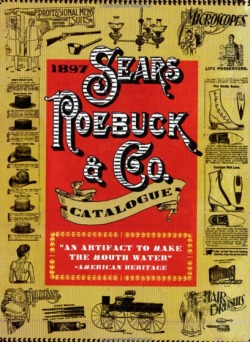
And yet...
I have a handful of different Sears Catalog reprints in my classroom and if I scatter them around on student desks before class begins, within moments, students have been totally sucked into them.
Yes, the boys go immediately to the section on shotguns.
Yes, most of the girls go immediately to saddles and horse-tack.
So what? It's American History and they're engrossed. (And they rarely stay in those sections.)
The items being sold give a unique view into consumer culture at the turn of the 20th Century and into Victorian culture generally. This catalog wasn't originally printed to teach anybody anything - it was there to sell stuff. They only sold things that people wanted to buy. The fact that people wanted to buy them tells us a lot.
For instance...
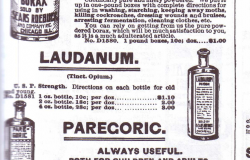
And I mean ANYTHING (as long as it didn't have any depiction of the human body - we are talking about the Victorians, here...)
I always have to explain what laudanum is, but that starts a discussion that goes here...
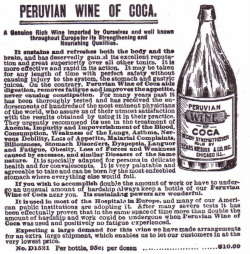
[They are always a little stunned that you could buy this sort of thing in a family catalog during the Victorian age, but could serve hard jail time for owning a dirty magazine.
During our Civil War Pension Project, they had seen that even medical charts were discretely covered by fig leaves in strategic places.]
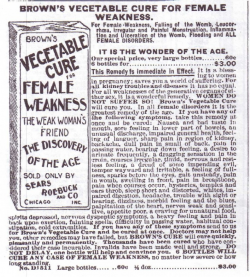
...and ends up here.
The idea that the Government wouldn't regulate medicines is hard for some of them to wrap their heads around.
This particular patent medicine opens up several meaty discussions, not least of which is how society viewed women.
The list of symptoms that Brown's Vegetable Cure supposedly alleviated is fascinating. a partial list includes:
- backache
- dull pain in the small of back
- pain in passing water
- bearing down feeling (whatever that is...)
- a dragging sensation in the groin (not sure I really want to know...)
- courses irregular (presumably a discrete way of referring to a menstrual cycle.)
- timid, nervous and restless feeling
- (my particular favorite) a dread of some impending evil
- sparks before the eyes
- hysterics
- trouble with sight or hearing
- a craving for unnatural food
- habitual constipation
- cold extremities
[Side note - A history professor I consulted suggests that perhaps the reference to "courses irregular" could be Victorian code for ending an unwanted pregnancy. Interesting - jf]
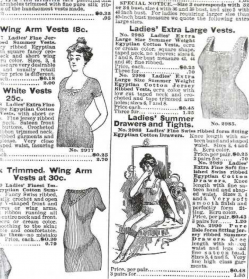
That discussion leads fairly naturally to discussing Victorian underwear.
As in the 10-15 pounds of it that middle/upper-class women were expected to wear on a daily basis.
Starting with the "vest" or long underwear, which was made of cotton by the time this catalog was printed in the 1890s, but which had often been made of wool, earlier in the century.
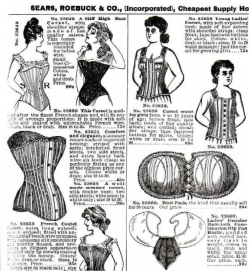
(I say "minefield", because it is such an emotional discussion, but a really good one.)
This is an amazing discussion because it goes in a couple of directions that students don't expect but really appreciate. For instance:
- The discussion of Unreasonable Body Image - how few modern women meet our standard of lingerie-model beauty. I tell them briefly about the Flapper period of the 1920s, where women were expected to strap down their breasts and look as streamlined as possible. Then we talk about the classic hourglass shape that women in the late 1800s were expected to have. I read that quote from Laura Ingals Wilder about how a man should be able to fit his hands around his wife's waist on her wedding day.
- We talk about the extremes that women - then and now - were willing to go to to meet the unreasonable body image. They all agree that it is wrong - just plain wrong for a woman to permanently alter her body for the sake of fashion. Then I ask them how many of them are planning on getting a tattoo someday. (Then I explain that I'm not putting down tattoos precisely - I just want them to see that they aren't so different from these Victorian women.)
- We talk about the image of Victorian women as being delicate blossoms who faint at the slightest sign of any excitement. (They usually make the connection on their own that it was because women back then couldn't breathe!) We talk about how stereotypes tend to re-enforce themselves. (Women were too excitable, so they had to be "protected" from ideas and careers and possibly medicated with laudanum, which made them pretty much incapable of accepting new ideas or holding down careers, which left them bored and craving stimulation, which they satisfied with drugs and fashion, which just intensified the whole situation...)
This discussion was SO meaty and raised SO many questions that I emailed a couple of History/Women's Studies professors I know for some answers. We ended up Skyping one of them during one of my classes to ask even more questions. Here are a few of the more intriguing answers:
- Yes, women did wear corsets during pregnancy - usually "lesser corsets" with the belly exposed, during the final stages of pregnancy. Women who habitually wore tightly-laced corsets did not have enough core body strength to support even their own weight very well, much less that of a pregnant belly.
- Because of this lack of muscle-tone, an under-appreciated cause of death in childbirth was women who were incapable of pushing during delivery.
- Young girls usually started wearing corsets a couple of years before starting their periods, but even babies were sometimes loosely corseted to help nudge their skeletons into the proper hourglass shape as they developed.
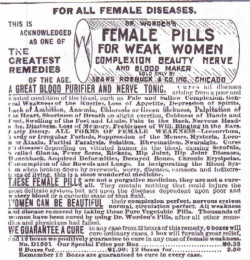
- sore feeling in the lower part of the bowels
- sharp pain in region of kidney
- dull pain in small of back
- gait unsteady
- temples and ears throb
- dizziness
- appetite poor
- fainting spells
- partial paralysis
- shortness of breath on slight exertion
- coldness of hands and feet
- feebleness of will
- anemia
- swelling in the feet and limbs
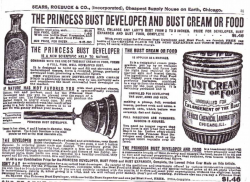
(How to put this delicately...)
((Well, actually, there is no way to put it delicately.))
The quest for bigger boobs is not a modern phenomenon. I particularly call your attention to the device on the left - a sort of bronze suction-cup with attached piston.
I especially like the ad copy - "IF NATURE HAS NOT FAVORED YOU..."
- Why does 60% or so of the population get this kind of focus in my class only during a two-three day mini-unit? Yes, I know that unable to vote, run for office, own land or serve in the Military, women's impact on American History has always been somewhat muted. I certainly tell myself that often enough. Should I be finding other ways of having this kind of conversation more often? As a man, would it be out of place (or even creepy) for me to give more focus to intimate women's issues?
- Well, in that case, should we think about teaching Women's Studies in middle school? Waiting until college seems like a lost opportunity. Besides - there are tremendous opportunities for inter-disciplinary crossover here. Literature, Math, Health and PhysEd could all link up very neatly, just in the discussion of corsets.
- Should I think about building a whole unit (as opposed to the current mini-unit) based on the Sears Roebuck catalog? Where would I find the time? I'm already cutting my other units to the bone. Would a catalog unit be more important than Westward Expansion? The Bill of Rights? Slavery?
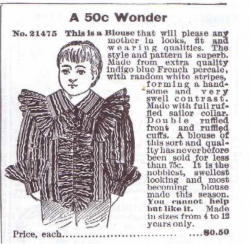
I don't know.
I do know this, though. I would dearly like - just once - to see my son in one of these.
 RSS Feed
RSS Feed